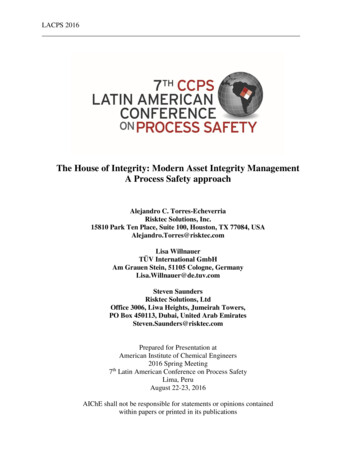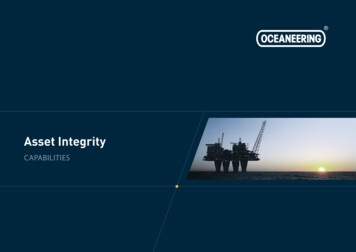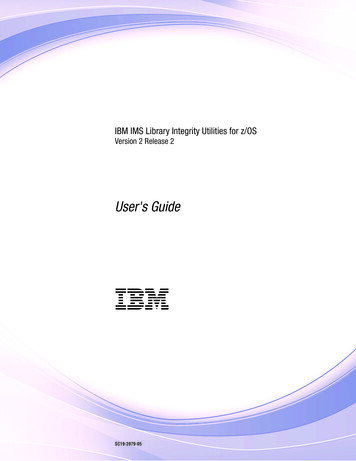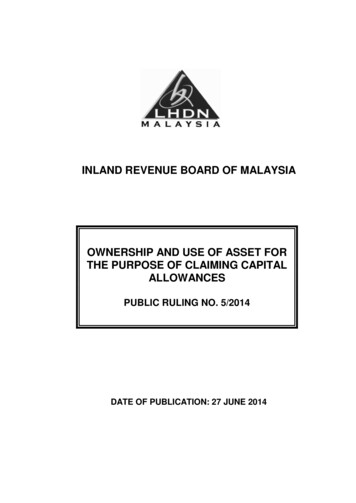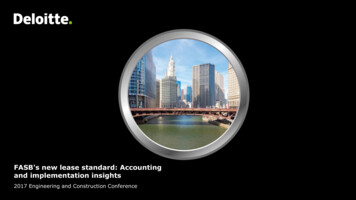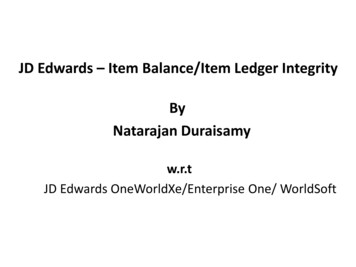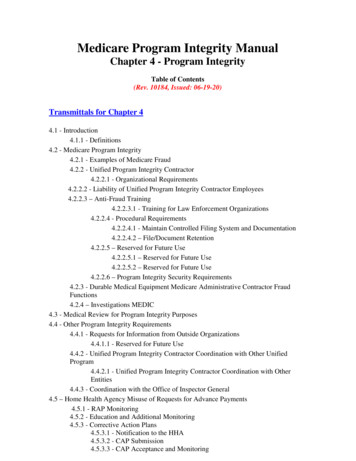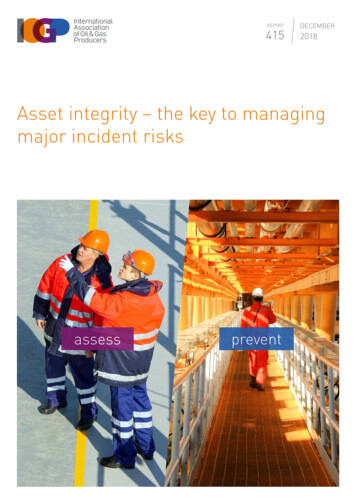
Transcription
REPORT415DECEMBER2018Asset integrity – the key to managingmajor incident risksassessprevent
AcknowledgementsSafety CommitteePhotography used with permission courtesy of Alvov/Shutterstock and petroleum man/Shutterstock (Front cover) Sascha Burkard/iStockphoto (Back cover)FeedbackIOGP welcomes feedback on our reports: publications@iogp.orgDisclaimerWhilst every effort has been made to ensure the accuracy of the informationcontained in this publication, neither IOGP nor any of its Members past present orfuture warrants its accuracy or will, regardless of its or their negligence, assumeliability for any foreseeable or unforeseeable use made thereof, which liability ishereby excluded. Consequently, such use is at the recipient’s own risk on the basisthat any use by the recipient constitutes agreement to the terms of this disclaimer.The recipient is obliged to inform any subsequent recipient of such terms.This publication is made available for information purposes and solely for the privateuse of the user. IOGP will not directly or indirectly endorse, approve or accredit thecontent of any course, event or otherwise where this publication will be reproduced.Copyright noticeThe contents of these pages are International Association of Oil & Gas Producers.Permission is given to reproduce this report in whole or in part provided (i) thatthe copyright of IOGP and (ii) the sources are acknowledged. All other rights arereserved. Any other use requires the prior written permission of IOGP.These Terms and Conditions shall be governed by and construed in accordancewith the laws of England and Wales. Disputes arising here from shall be exclusivelysubject to the jurisdiction of the courts of England and Wales.
REPORT415DECEMBER2018Asset integrity – the key tomanaging major incident risksRevision historyVERSIONDATEAMENDMENTS2.0December 2018Minor corrections1.0December 2008First release
Asset integrity – the key to managing major incident risksContentsScope5Foreword61. Introduction72. Asset integrity risk management process93. Barriers134. Integrity throughout the asset life cycle175. Human factors216. Competences247. Monitoring and review27Appendix A – Question set30Glossary37References394
Asset integrity – the key to managing major incident risksScopeIOGP’s Managing Major Incident Risks Task Force developed this guide tohelp organisations reduce major incident risks by focusing on asset integritymanagement. It may be applied to new and existing assets at every life cycle stage.The information presented within it is derived from good practices in matureoperating areas where operators are required to provide structured evidence ofsound risk management practices.Although this guide may be used by anyone who contributes to the management ofasset integrity, it is particularly targeted at senior managers, including those froma non-technical background, who lead operating organisations. Use of the includedquestion set (Appendix A) can help assure that major incident risks are suitablycontrolled.This report includes references for those who require more in-depthunderstanding of asset integrity management.5
Asset integrity – the key to managing major incident risksForewordIOGP Report 415, Asset Integrity – the key to managing major incident risks was firstpublished in 2008. It explicitly addressed asset integrity and process safety risksas part of a company’s overall management systems. Since then, approaches havecontinued to evolve.Although this 2018 version of the report updates the formatting and branding, itsees only minor changes to the content.Report 415 remains an informative overview and introduction to the concepts andmanagement of asset integrity, within a company’s overall Management System.Readers wishing to deepen their knowledge or seeking more recent guidanceare encouraged to consult the IOGP reports mentioned below. All are available todownload from the IOGP online library http://www.iogp.org/Our-libraryGuidance on establishing an Operating Management System (OMS) is nowintegrated within IOGP Report 510, Operating Management System Frameworkfor controlling risk and delivering high performance in the oil and gas industry,published in 2014. Reports 415 and 510 both provide guidance on how to applyrisk management as a fundamental process that puts planned measures in placeto eliminate or reduce release of hazardous fluids by applying risk controls. IOGPReport 511, OMS in practice - A supplement to Report No. 510, Operating ManagementSystems Framework provides further guidance on establishing a new managementsystem, or reviewing an existing one. Readers interested in leadership and safetyculture are also directed to IOGP Report 452, Shaping safety culture through safetyleadership.Report 415 introduced the concept of establishing a set of barriers, each of whichrepresents a grouping of risk controls. This was further developed in Report 544,Standardization of barrier definitions, published in 2016.In 2011, IOGP published Report 456, Process Safety – Recommended Practice on KeyPerformance Indicators establishing four tiers of Key Performance Indicators tocollect data on significant loss of primary containment events (Tiers 1 and 2) andto establish leading indicators to assess strength of barriers. The 2018 version of456 took the barrier categories defined in Report 544 and proposes an approach toleading KPIs at Tier 3 and 4 levels.IOGP started data collection of Tier 1 and 2 process safety events in 2010 and haspublished it annually since 2011.6
Asset integrity – the key to managing major incident risks1. IntroductionE&P organisations need to manage a complex portfolio of risks. These rangefrom minor events to major incidents that may involve serious personnel injuries,significant environmental damage, or substantial financial impact.Over the past three decades, the development and implementation of structuredHealth, Safety and Environmental Management Systems (HSE-MS) have provided aframework within which hazards and the risks they pose can be identified, assessedand managed. The substantial improvements the industry has seen in Lost TimeInjury Frequency (LTIF) and Total Recordable Incident Rates (TRIR) over this period(see Figure 1) are, in part, testament to the benefits of a systematic approach to riskmanagement where there are close links between hazards and consequences.Asset IntegrityWithin this guide, asset integrity is related to the prevention of major incidents.It is an outcome of good design, construction and operating practices. It isachieved when facilities are structurally and mechanically sound and performthe processes, and produce the products, for which they were designed.The emphasis in this guide is on preventing unplanned hydrocarbonreleases that may, either directly or via escalation, result in a major incident.Structural failure or marine events may also be initiating causes that escalateto become a major incident. This guide applies to such events, but there maybe additional considerations not covered here.Broader aspects of asset integrity related to the prevention of environmentalor commercial losses are not addressed. However, subject to appropriateprioritisation, the same tools can be applied for these risks.In contrast to occupational injuries, large losses are typically the result of thefailure of multiple safety barriers, often within complex scenarios. These aredifficult to identify using a simple experience-based hazard identification and riskassessment process. Good occupational health and safety performance of anasset does not guarantee good major incident prevention. A common ‘continualimprovement management system’ may be used, but additional technical skillsand competences are needed to manage major incident risks. It is important tounderstand that the application of suitable equipment technical standards, thoughvital, is not a sufficient requirement for the prevention of major incidents. Wellmanaged organisational practices and individual competences are also necessaryto ensure the selected barriers remain effective.This guide summarises ways to manage major incident risk throughout the lifecycle of E&P operations. It outlines processes and tools that explicitly addresssuch risks within an overall HSE-MS or corporate risk management system. It also7
Asset integrity – the key to managing major incident risksincludes examples of risk management process failures that could lead to a majorincident.Lost time injury frequency (per million hours worked)Total recordable injury rate (per million hours worked)Being able to work with an inherently hazardous product in a safe andenvironmentally responsible manner is critical to the success of any E&Porganisation. Major incidents can have severe consequences for people, theenvironment, assets and company reputation. Although the risks of major incidentscan never be reduced to zero, a systematic risk management process – as outlinedin this guide – can significantly reduce their likelihood and limit their effects.1086420‘95 ‘96 ‘97 ‘98 ‘99 ‘00 ‘01 ‘02 ‘03 ‘04 ‘05 ‘06 ‘07 ‘08 ‘09 ‘10 ‘11 ‘12 ‘13 ‘14 ‘15 ‘16 ‘173.53.02.52.01.51.00.50.0‘95 ‘96 ‘97 ‘98 ‘99 ‘00 ‘01 ‘02 ‘03 ‘04 ‘05 ‘06 ‘07 ‘08 ‘09 ‘10 ‘11 ‘12 ‘13 ‘14 ‘15 ‘16 ‘17Figure 1: Overall Total Recordable Injury Rate and Lost Time Injury Frequency (1995-2017)reported to IOGP by IOGP Members (company and contractor data).8
Asset integrity – the key to managing major incident risks2. Asset integrity riskmanagement processThe outline process in Figure 2 is based on a standard continual improvementcycle: Plan, Do, Check, Act (PDCA).Minor variations from this process and terminology may be used in othermanagement system documents or standards. The five steps shown shouldpreferably be part of the design process, but they may also be applied to existingassets, and be continued throughout their life cycle.Major incidentAn unplanned event with escalation potential for multiple fatalities and/or serious damage, possibly beyond the asset itself. Typically, these arehazardous releases, but also include major structural failure or loss ofstability that could put the whole asset at risk.Review of the entire process at intervalsto ensure it continues to be effectiveEstablish contextRisk onAnalysisMonitoringandreviewEvaluationControl risksThis underpins the overall risk managementprocess, should occur throughout the cycleand be two-ways, as shown by the arrowsMonitoring at every stage, feedingback to improvements based onincreased understandingFigure 2: Example risk management process as described in IOGP Report 510,Operating Management Systems Framework9
Asset integrity – the key to managing major incident risksStep 1. Establishing the context“What drives us?”Aspects include:External context – factors outside the organisation such as: applicable legislation, codes and standards (including the terminology used) key stakeholders such as partners, regulators, local communities, NGOs,major contractors and suppliers.Some applicable regulations or standards may specify standard safeguards andthus limit risk treatment optimisation as described in step 4.Internal context – factors inside the organisation and, for this guide, only thosehazards that could result in a major accident such as: corporate risk management standards, their processes and targets governance systems including internal organisation and delegation ofresponsibilities internal capabilities including persons who operate, maintain and manageactivities at the facility.Step 2. Communication & consultation“Who else should be involved?”The types, frequencies, style and content of communications should be determinedby the internal and external standards, documents, stakeholder groups, etc.identified in step 1.Step 3. Risk assessment“What can happen?” (a process carried out in the three sub-steps inFigure 2)1. Risk identification (may also be termed Hazard identification)Identifies potential harm to people, the environment and assets. Unless applicablemajor incidents are identified, steps cannot be taken to eliminate or control them.10
Asset integrity – the key to managing major incident risks2. Risk analysisThis stage involves realistic and detailed consequence assessments. An examplewould be to estimate how much gas or liquid might be released in the event? Or bywhat mechanisms could an initial small release escalate to affect people and otherequipment? Risk Assessment Data can be used to estimate event frequency, see forexample IOGP Report 418, Risk Assessment Data Directory and its related reports.3. Risk evaluationIt is very important to determine what level of risk is tolerable. For a new design,a wide range of risk reduction (treatment) options exist; for existing assets, thescope may be limited. Options generally include elimination, prevention, control,mitigation and recovery. Elimination is the best way to deal with hazards but is notalways practical.For hazards that cannot be eliminated, other treatments should be considered anda cost-effective combination selected (see step 4).Step 4. Risk treatment“What do we do?”Risk treatment involves considering the feasible options and deciding on theoptimal combination to minimise the residual risk so far as is reasonablypracticable. This step lies at the heart of the overall asset integrity managementprocess. Successful risk treatment includes ensuring the selected barriers areactually in place, not just ‘on paper’.Engineered safeguards are typically more reliable than procedural ones (seeBarriers). Likewise, passive systems such as use of open space, gravity drainageand natural ventilation are typically more reliable than systems requiring activationsuch as firewater, foam, emergency teams, emergency isolation valves and blowdown. But no safeguards are infallible. Therefore, a combination of both activeand passive systems is typically used to minimise the consequences of integrityloss and expedite recovery. Some risk treatment options may not be possiblefor an existing asset (e.g., increasing open spaces); others may involve majormodifications, requiring appropriate evaluation of the risk reduction benefitsrelative to the costs.IOGP Report 544, Standardization of barrier definitions was published in 2016 tohelp standardise barrier type and categories of processes safety barriers.11
Asset integrity – the key to managing major incident risksStep 5. Monitoring and review“What could we do better?”“What can we learn from ourselves and from others?”As an asset is designed, constructed, operated, maintained and modified, theunderstanding of associated risk and good practices for its treatment will improve.This allows better risk management. It is also important to review periodically theapproach taken for asset integrity risk management; ensuring that new knowledgeis considered, changes are understood and the selected barriers continue to becost-effective.This review step is also important for newly acquired mature assets, or thosebeing systematically risk-assessed for the first time. Some of the original designphilosophy or key maintenance records may not be available and the use ofadditional barriers may be prudent until integrity monitoring provides sufficientexperience or knowledge of the asset to make informed risk managementdecisions. Changes in key operating parameters (pressure, temperature,composition, etc.) should also trigger an overall review of asset integrity riskmanagement.12
Asset integrity – the key to managing major incident risks3. BarriersBarriers are the functional groupings of safeguards and controls in place toprevent the occurrence of a significant incident.A good way to understand barriers is a model that likens them to multiple slices of‘Swiss cheese’, stacked together side-by-side1. Each barrier is represented as onecheese slice. The holes in the slice represent weaknesses in parts of that barrier.Incidents occur when one or more holes in each of the slices momentarily align,permitting ‘a trajectory of accident opportunity’ so that a hazard passes throughseveral barriers, leading to an incident. The severity of the incident depends onhow many barriers (cheese slices) have holes that line up at the same time.BarrierA risk control that seeks to prevent unintended events from occurring, orprevent escalation of events into incidents with harmful consequences.(From IOGP 510)Figure 3 illustrates two primary types of barrier: hardware barriers and humanbarriers as defined in IOGP 544, Standardization of barrier definitions. Hardwareand human barriers are put in place to prevent a specific threat or cause of ahazard release event, or to reduce the potential consequences if barriers havefailed and an event has occurred.Both hardware and human barriers are supported by the processes andprocedures contained within the Management System Elements, such as thosein the Operating Management System in Report 510.1 Reason, J. Managing the risks of organisational accidents. Farnham: Ashgate Publishers, 1997.13
Asset integrity – the key to managing major incident risksHardwareHardwareThreat manHumanHardware barriersHuman barriersSafety System IntegrityOperating DisciplineManagement System Elements*Supports hardwareand human barriers* i.e. processes and procedures within the Management System elementsHardware barriersPrimary containment, process equipment and engineered systems designedand managed to prevent LOPC and other types of asset integrity or processsafety events and mitigate any potential consequences of such events. Theseare checked and maintained by people (in critical activity/tasks).Human barriersBarriers that rely on the actions of people capable of carrying out activitiesdesigned to prevent LOPC and other types of asset integrity or process safetyevents and mitigate any potential consequences of such events.Management System ElementsManagement System Elements that group processes and practices designedto prevent LOPC and other types of asset integrity or process safety eventsand mitigate any potential consequences of such events. Management SystemElements support hardware and human barriers.Figure 3: Barrier types as described in IOGP 544, Standardization of barrier definitions14
Asset integrity – the key to managing major incident risksThe ‘Swiss cheese’ model asserts that no barrier is ever 100% effective because‘holes’ are always present, even though each may be temporary. The aim shouldbe to identify holes and then make them as small and as short-lived as possible,recognising that they are continually changing (equipment deterioration, temporarysafeguard bypasses, operational changes, maintenance lapses, personal and teamcompetences, etc.). Hence, multiple barriers are used to manage the risk of majorincidents, thereby reducing the chance that all of the holes ‘line up’ and the worstcase event is realised.An alternative way to visualise and determine the need for barriers is to use thebow tie model. This indicates how barriers can both reduce the threats from ahazard and limit consequences if the hazard is realised.The number of barriers (hardware or management system) for an asset shouldbe held at a logical and manageable level, usually less than 20. A listing ofindividual ‘critical equipment items’ could number thousands and make systematicmanagement more difficult.A detailed description is needed of the operational performance requirements forthe whole barrier to meet the intended risk reduction. Hence, the Control risksstage in Figure 2 has three levels of increasing detail:1)define barriers at a system level2)define high level performance requirements for each barrier3)define the required performance standards in detail including those forconstituent parts as appropriate.Within each barrier, individual hardware items may be suitably itemised andpriortised for criticality using risk criteria.Performance standards for barriersPerformance standards for barriers are typically described in terms of functionality,availability, reliability and survivability. Performance standards thus determineequipment design specifications (original suitability) and also set requirements formaintenance and testing throughout the asset’s life cycle (ongoing suitability).It is helpful to consider a range of possible performance standards for eachcomponent – typically based on recognised design standards – and then optimisethe overall barrier to give a cost-effective risk reduction. Such barrier optimisationneeds input from designers, operations and often risk assessment specialists toensure that all relevant factors are considered. There can also be performancestandard optimisation between barriers.15
Asset integrity – the key to managing major incident risksExampleA faster blow-down time may reduce the fire protection requirements, butmay also result in additional pipework, cooling or increased flare radiation.Once performance standards are defined, assurance processes should be put inplace to confirm that barriers remain fit for purpose. Typically, this will require initialequipment type-testing and/or barrier commissioning performance tests; operationalcontrols and limits; maintenance, inspection and testing plans; performance recordsfor both individual equipment items and the overall barriers; and audit and review.Performance standards may be changed over a facility’s life cycle to reflectchanges in operating parameters or a need to improve inspection and leakdetection if process equipment deteriorates.Emergency responseAs noted above, one or more of the defined barriers should be emergencyresponse: an optimised mix of hardware, procedures and personnel, withassociated performance standards. However, as asset integrity improves, thejustification for extensive emergency response (mitigation and recovery barriers)may reduce. Consequently, it can be challenging to convince designers andoperators working hard to ensure asset integrity that they should also plan andimplement robust emergency response barriers in case integrity is lost.The major incident scenarios for which the emergency response barriers shouldbe designed will be those identified in step 3 of the risk assessment process. Thisassumes full or partial failure of the preceding barriers, as appropriate.Similar scenarios and barrier failures may be used as a basis for operationaltraining and assessment of the facility emergency response procedures and people,including both front-line personnel and those responsible for managerial response.Such training reinforces understanding of the purpose of major incident barriers andhelps to ensure that suitable, timely actions are taken if their performance degrades.Performance standardA measurable statement, expressed in qualitative or quantitative terms, of theperformance required of a system, item of equipment, person or procedure,and that is relied upon as the basis for managing a hazard.16
Asset integrity – the key to managing major incident risks4. Integrity throughout the assetlife cycleConcept selectionOptimising early design choices can positively influence asset integrity cost andeffectiveness throughout the life of a facility. However, optimisation also takes timeand resources. Therefore, it requires organisational leadership that recognisesand balances asset integrity and full life cycle costs against a design with a lowercapital cost or shortest construction time.Some design concepts are inherently more reliable than others. Identifying keyhazards and the barriers needed to control them will also help avoid conceptswith hard-to-manage asset integrity issues. Concept design decisions may alsodetermine other operations and maintenance activities which have their ownimpacts on asset integrity risks.ExampleCorrosion resistant pipework fully rated for maximum pressure is lesslikely to fail due to overpressure or corrosion than pipework that relies oninstrumented pressure protection and the addition of corrosion inhibitors tomaintain integrity, but there may be higher costs and other issues.Performance standards for the main asset integrity barriers should be set duringthis stage to ensure fair comparison of options. It is easy to underestimate thetrue cost of future operations and maintenance. Doing so could result in underinvestment in asset integrity related capital equipment. After concept selection,there is less available flexibility for eliminating hazards, reducing risk, orsimplifying asset integrity management.ExampleSelecting a diesel-powered main generator rather than an external electricsupply requires consideration of: main generator system maintenance and backup local diesel storage facilities and increased fire protection in case of lossof storage integrity diesel-supply operations with associated transport and transfer spillagerisks.17
Asset integrity – the key to managing major incident risksAsset definitionAs asset design is developed, the barriers for maintaining asset integrity shouldbe worked in parallel. Overall performance standards for the main barriers shouldalready be defined, so performance standards for systems and sub-systemsshould be ready to be determined. This ensures that equipment specifications takeaccount of maintenance needs and operational capacities.ExampleIt is unreasonable to expect 96% uptime if key equipment requires 15 daysannual inspection downtime, as there is then no contingency for any otherdowntime, planned or unplanned.Barrier maintenance, inspection and testing requirements, including estimatesof the associated system downtimes, are a design deliverable at this stage.It is also important to ensure the selected design is suitable for the ultimatedecommissioning requirements.At this stage a catalogue of applicable codes and standards should be compiled,with particular reference to those required to assure strength of the barriers.ExampleMust just the asset be totally recyclable, or must all land or seabedcontamination also be removed?This catalogue reduces the potential for misunderstandings or disputes aboutrequired barriers and performance standards during later stages. Also, byidentifying and applying appropriate codes and standards, an initial estimate ofresidual risk can be made through comparison with a similar plant.Detailed designBy this point, most key asset integrity decisions have been made. However, inadequateattention during detailed design can significantly reduce asset integrity by makingplanned barriers ineffective. Full documentation is needed to describe the assetdesign, operating and maintenance strategies, and the major hazards managementphilosophy. Maintenance, inspection and testing routines should be developed forall barriers. Risk assessments should demonstrate that hazards and risks areappropriately managed through equipment specifications (plant), procedures and18
Asset integrity – the key to managing major incident risksdelegated responsibilities (process), and competent personnel (people). Operabilityreviews and familiarisation by maintenance and operations personnel shouldcommence during this stage, and continue through the construction stage.At the completion of this stage all asset integrity barriers should be fully definedand documented.Construction and commissioningIt is critical to ensure that any necessary changes made to the design are suitablymanaged and authorised so as to maintain asset integrity standards.All required operating, maintenance and testing procedures should be finalisedbefore commissioning begins, and competent personnel should be recruited andtrained. This ensures that, as far as possible, the procedures and people elementsof major incident barriers are fully functional when the plant elements are firstoperated. System commissioning tests may be needed to verify the functionalperformance elements of some barriers, e.g., blow-down systems, isolation valves.Operation, modification and maintenanceAsset integrity barriers defined in the earlier stages should be implemented,continuously monitored and maintained. Subsequent changes to asset design,operating limits or maintenance frequencies should be subject to changecontrol and review by a competent technical authority. This is also the time foroperating limits to come into play, including control of system over-rides. Barrierperformance should be tested regularly and deficiencies appropriately addressed.To the extent that the earlier concept selection stage eliminated or reducedhazards, the need for ongoing intervention, maintenance and testing tasks can begreatly reduced. This can be particularly important with higher hazard materialsand operating conditions, e.g., HPHT reservoirs, high H2S levels. Operations andmaintenance managers should have the relevant competencies to understandand communicate major incident hazards and to describe how the equipment andprocedures are designed to provide suitable and reliable asset integrity barriers,including recovery from minor deviations.With operating conditions changing over time, an initial design premise may nolonger be valid. Such changes potentially affect operating limits and so shouldbe covered by the change control process. Codes and standards may also changewithin the life cycle of the facilities. The original design should be reviewed againstsuch changes to see if modifications are required by regulation or justified forreduction of new or newly understood risks.19
Asset integrity – the key to managing major incident risksExampleA reservoir may produce solids (sand or proppant), water or unexpectedhazardous substances (H2S, mercury, CO2, etc.)AcquisitionWhen considering asset acquisition, at whatever life cycle stage, the availability ofessential asset integrity information should be checked as part of the
2. Asset integrity risk management process 9 3. Barriers 13 4. Integrity throughout the asset life cycle 17 5. Human factors 21 6. Competences 24 7. Monitoring and review 27 Appendix A - Question set 30 Glossary 37 References 39 Contents 4 Asset integrity - the key to managing maor incident risks


